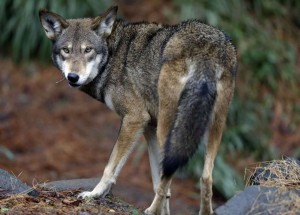It is amazing the statements of the Governors… They claim no wolves lived there…. and they would know this how????
Wildlife commission has options in wolf debate
by Collin Szewczyk, Aspen Daily News Staff Writer
Draft resolution features two alternatives opposing Mexican gray wolves coming to Colorado
The Colorado Parks and Wildlife Commission will have two alternatives in a draft resolution concerning wolf reintroduction at a meeting scheduled for next week in Denver.
The discussion comes on the heels of a proposal to move Mexican gray wolves into the Four Corners region to help the species expand its range.
But that proposal has been panned by the governors of Colorado, New Mexico, Arizona and Utah, all of whom wrote a letter to U.S. Fish and Wildlife Service Director Daniel Ashe and Interior Secretary Sally Jewell in November. The letter said the state leaders had “serious concerns” about the proposed recovery plan.
The governors argue the wolves never lived north of the area now bisected by Interstate 40, and that the recovery efforts should focus on land in Mexico.
Both alternatives in the draft resolution oppose efforts to bring the Mexican gray wolf to Colorado, similarly stating that this area wasn’t part of the endangered animal’s range.
“Colorado is not part of the historic range of the Mexican wolf; the historical range of this subspecies of the gray wolf is restricted to Mexico and the southwestern United States,” the draft notes.
There are currently 109 Mexican wolves in Arizona and New Mexico as a result of animal releases that began in the late 1990s, all stemming from a captive breeding population of seven wolves.
The second alternative also adds that no wolves should be brought back to the state via reintroduction plans.
The “Colorado Parks and Wildlife Commission affirms its support of the Wolf Working Group’s recommendations adopted by the Wildlife Commission in May 2005, recommends that Mexican wolf recovery efforts be confined to the subspecies’ historic range, and emphasizes the importance of bi-national recovery planning with Mexico,” the first alternative states.
The second alternative includes the statement that CPW “opposes the intentional release of any wolves into Colorado.”
What’s unclear is if the first alternative could open the window for future reintroduction programs in Colorado.
Matt Robbins, public information manager for CPW, said the alternatives arose from a discussion at a November commissioner meeting.
“It really reflects the range of the conversation,” he said of the alternatives.
Bill Kane, a former Basalt town manager and now a CPW commissioner, said that however the resolution turns out, it will simply be the commission’s recommendation for the wildlife agency on how to move forward on the issue. It will not set any law.
He added that the main reason the issue came before the commission was to give further support for Gov. John Hickenlooper’s opposition on the Mexican wolf entering the state.
“We could adopt the resolution, adopt a resolution with changes, or decide that a new resolution isn’t necessary,” he said Tuesday.
Kane, one of 11 commissioners who will address the issue on Jan. 13, added that the draft resolution is mainly focused on the Mexican wolf, but wouldn’t elaborate further before the discussion.
A 2004 Wolf Management Working Group report states that if wild wolves stray down from the north, they are to be welcomed in Colorado, where they are protected under the Endangered Species Act.
Draft resolution 16-01 includes a list of management concepts from the report. Those include: accepting a wolf presence in Colorado with conditions; urging that wolves migrating into Colorado be allowed to live with “no boundaries” where they find habitat; advocating that wolves be left wherever found, provided they are not causing problems; taking measures to avoid conflicts through non-lethal methods if possible; and recommending that funding for wolf management come from sources other than hunting license sales.
The working group’s report suggests that “when negative impacts occur, they should be addressed on a case-by-case basis utilizing a combination of appropriate management tools and damage payments.”
It would also allow the hunting of wolves “to manage depredations.”
Only the U.S. Fish and Wildlife Service could approve a wolf reintroduction program in Colorado. The last native wolves in the state were killed off in the early 1940s.
The Aspen Center for Environmental Studies’ Naturalist Nights this week hosts a series called “Should Gray Wolves be Restored to Colorado?” The first presentation takes place at 5:30 p.m. today at Carbondale’s Third Street Center, and another is set for 7 p.m. on Thursday at ACES’ Hallam Lake site.
Source: Wildlife commission has options in wolf debate | Aspen Daily News Online

